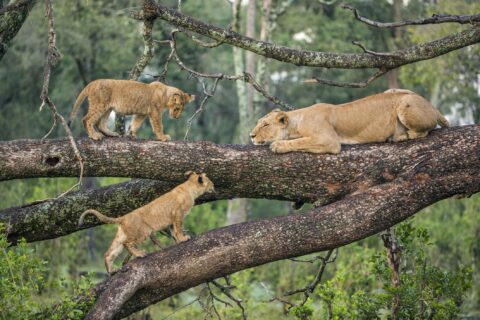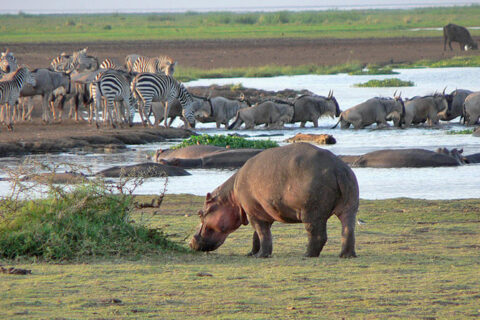Location of Lake Manyara National Park
Located in the northern part of Tanzania, Lake Manyara National Park is 126 kilometers west of Arusha Town. The park covers an area of 330 sq km / 125 sq mile including a lake surface of 230 sq km / 89 sq miles.
Lake Manyara Wildlife
Lake Manyara has a big number of elephants, so many giraffes; zebras, wildebeests, impalas, waterbucks, and warthogs, the less-known shy Kik’s dik dik as well as the Klipspringer that dwell along the ramps of the escarpment. Leopards are hosted within the scattered forests and escarpment, while the healthy population of lions that are widely known for their unique tree climbing capability. In addition, you will not fail to notice the very large number of baboons in this park which can live in sizeable troops of up to 200 members.
The Tree Climbing Lions of Lake Manyara NP
One would wonder, are there tree climbing lions in Lake Manyara National Park? Well, there is a thriving population of unique lions in the park which have the capability to climb tree; being nocturnal animals the animals spend most of their day resting up in the big fig trees and at sunset they descend when the temperatures are cooler. This is one of the only two populations of these unique lions the other being in Ishasha area in Queen Elizabeth National Park.
Bird watching in Manyara
With a Bird list of more than 350 species and an alkaline within the park’s boundaries, Lake Manyara National Park is without a doubt one of the best places to visit on a Tanzania Birding Safari. Large flocks of pelicans and pink flamingos are usually spotted in the middle of the lake. While the spoonbills, egrets, herons, stalks and other waders converge around the edges and water meadows. Other habitats such as the evergreen forests and other woodlands serve as a safe haven to many other species like the crowned eagles, created guinea fowl, and the noisy silvery cheeked hornbills.
Lake Manyara Eco System
There are various areas within the Park. Behind the splendid scenery of the Great Rift Valley’s steep escarpment in the west is the narrow area that safeguards the area between the escarpment and Lake Manyara. The silvery bowls of salt deposits facilitate the ability of the alkaline Lake Manyara to expand contract with the seasons. Grassy floodplains neighbour it so closely while bands of mixed acacia woodlands in the far end. There are also patches of ever green forests next to the escarpment that are watered by the perennial underground waters coming from the bottom of the escarpment.
Marvel at the large elephant herds
Lake Manyara National Park is home to a large number of elephants just as the neighboring Tarangire National Park and during your visit you will get a chance see them foliage around
Game Drives
The most commonly used mean of exploring this small but impressive northern Tanzania Game Park is through game drives. During the peak Tanzania safari season, the park is normally crowded with several safari vehicles especially during the afternoon game drives
Track the tree climbing lions
A large number of tourists that visit the Lake Manyara National Park do so to set eyes on these exceptional lions that have a unique character. These can be seen while in the comfort of your safari vehicles during the game drives as they rest on the large branches of the fig trees.See the large troops of baboons
On your Safari to Lake Manyara you will be impressed by the large troops of social baboons as they cater for their young ones, feed and play about.
Visit the ‘pink’ lake with flamingoes
The Alkaline Lake Manyara attracts a large number of pink colored flamingoes that form some sort of pin ‘blanket’ covering the lake surface. It is a breathtaking view to marvel at thousands of flamingoes all in one area. In addition, you won’t fail to notice a number of other wildlife within the shallows of the lake such as hippos.
Explore the Lake Manyara tree-top Walkway
This amazing canopy walk that gradually rises in height extends for over 360 meters offering you an opportunity to walk through the verdant tree top of the forest and see some of the unique wildlife including birds and monkeys.


